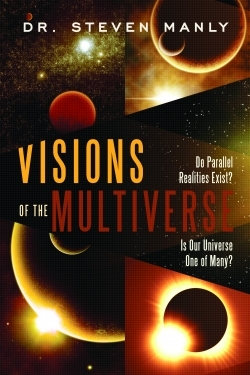Visions of the Multiverse
Dr. Steven Manly’s Visions of the Multiverse, begins with a welcome to “the multiple universe reality, whatever that is.” This tongue-in-cheek style permeates the conversational tone of a book that seeks to provide the layperson with a summary of various multiple universe theories. Despite his self-effacing style (Manly admits that “a few of the multiverse concepts described in this book are perhaps as fictitious as the Harry Potter series) his goal is to convince us that “the time has come to take seriously the idea of a multiple universe reality.”
Manly holds a PhD in Physics from Columbia University and teaches introductory physics courses at Rochester University. He has won several undergraduate teaching awards, including the New York State Professor of the Year in 2003. The author hints at his audience when he describes the conceptual physics in his new book as “not the same old boring stuff from high school.”
Manly’s irony entertains while piquing interest in a highly debatable realm of modern physics. Within his discussion of multiverse concepts, he includes anecdotes from popular culture, “… we all share the same concept of space and time. From Bill Gates to Sarah Palin to Yao Ming to Joe Smith, we see the world as three infinite and absolute spatial dimensions moving uniformly through absolute time in one direction.” In accessible language, he provides a comprehensive, historical overview of these introductory concepts of space, time, and light. Beyond Newton, Galileo, Copernicus and Einstein, Manly introduces names such as Feynman, Tegmark, and Lorentz, qualifying their credentials while explaining their contributions to the field of modern physics.
As a reference book for undergraduates or the layperson probing the controversial but compelling topic of multiverses, the two appendices provide an important framework. Appendix A contains an overview of multiverse concepts, such as space-time, many-worlds, and faith-based multiverses. Appendix B is a Taxonomy of Tegmark’s mathematical multiverse, a theory based on a mathematical “theory of everything” with the hypothesis that, “every mathematical structure is another universe.”
Although Manly’s tone borders on the sarcastic at times and some of his anecdotes seem tangential in places, he has succeeded in creating a succinct introduction to multiple universes within the historic context of theoretical physics. In his conclusion, Manly, like any good theorist, returns to inquiry, asking, “Do we live in multiple types of multiverses?” and if so, “Which ones?”
Reviewed by
Kai White
Disclosure: This article is not an endorsement, but a review. The publisher of this book provided free copies of the book and paid a small fee to have their book reviewed by a professional reviewer. Foreword Reviews and Clarion Reviews make no guarantee that the publisher will receive a positive review. Foreword Magazine, Inc. is disclosing this in accordance with the Federal Trade Commission’s 16 CFR, Part 255.

